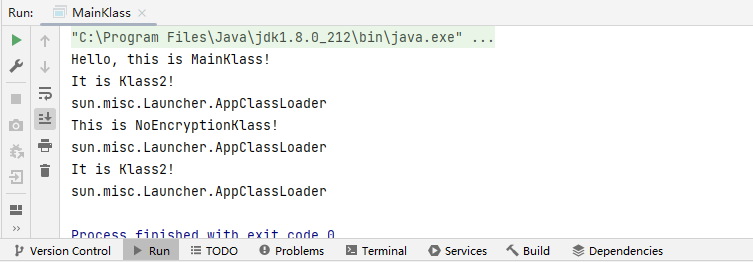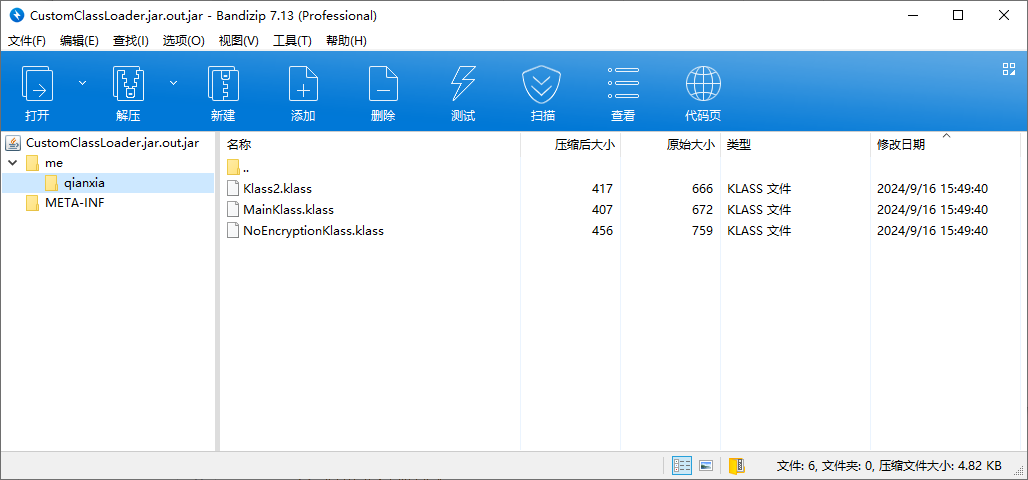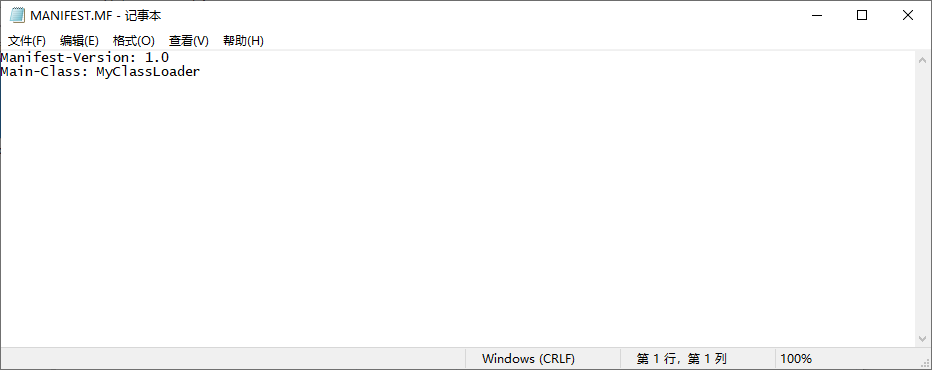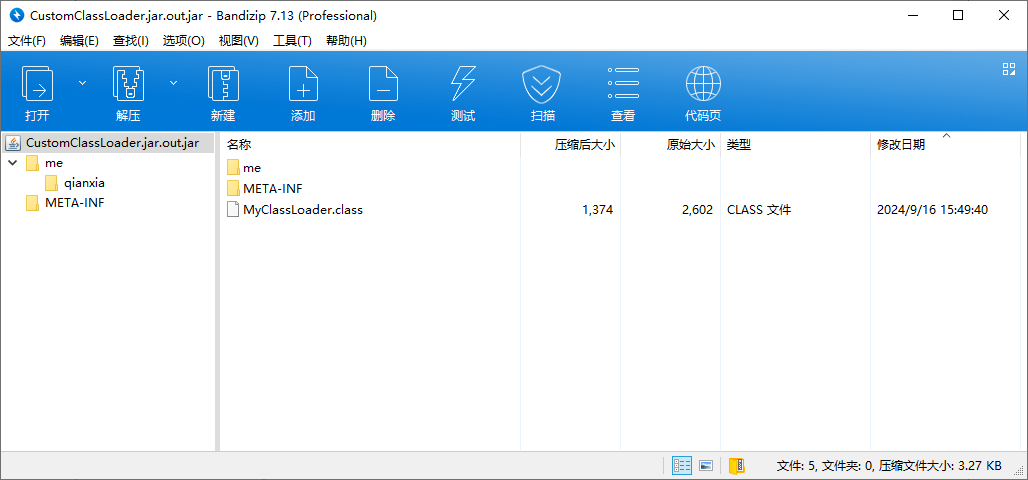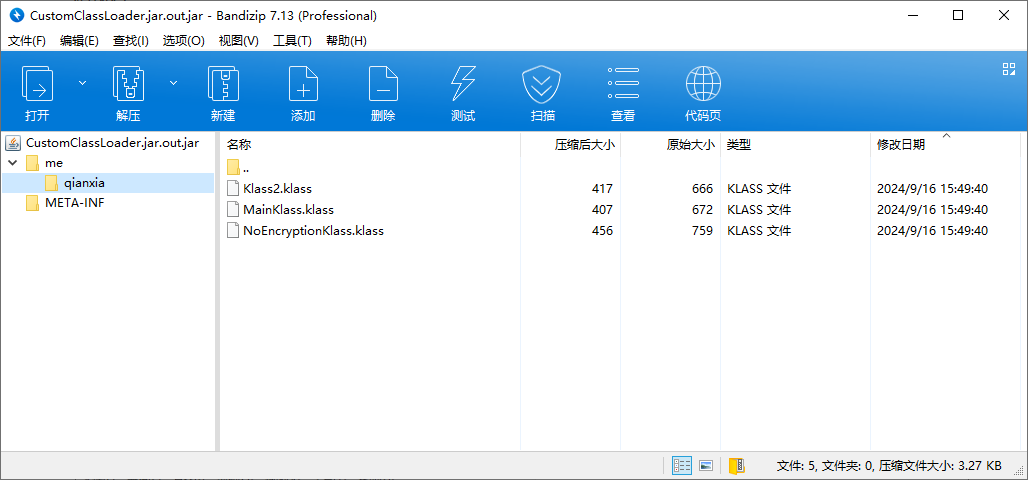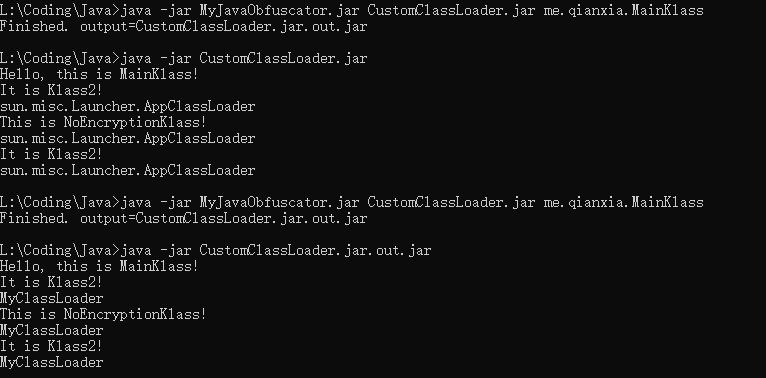通过自定义类加载器(ClassLoader)实现类文件加密保护
前言
由于Java语言自身特点,及其产生的中间代码中含有大量有意义的信息,Java的中间代码是易受攻击的。这里讨论一种基于Java自身灵活性实现的,通过自定义ClassLoader实现运行期解密已加密的类文件而保护类文件不被直接反编译。
原理
Java语言中,类的加载、连接和初始化都是在程序运行期间完成的。利用这样动态加载的特性,可以将Jar包中所有类文件预先加密,保留一个入口类文件未加密,通过自定义类加载器在运行时解密已加密的类文件,并将其作为二进制流加载。
实现
手动加密类文件
首先创建3个类MainKlass.class、Klass2.class和NoEncryptionKlass.class。其中me.qianxia.MainKlass为主类,含有main方法。
public class MainKlass {
public static void main(String[] args) {
System.out.println("Hello, this is MainKlass!");
Klass2.Hello();
NoEncryptionKlass.Hmmm();
}
}public class Klass2 {
public static void Hello() {
System.out.println("It is Klass2!");
System.out.println(Klass2.class.getClassLoader().getClass().getCanonicalName());
}
}public class NoEncryptionKlass {
public static void Hmmm() {
System.out.println("This is NoEncryptionKlass!");
System.out.println(NoEncryptionKlass.class.getClassLoader().getClass().getCanonicalName());
Klass2.Hello();
}
}上述代码运行结果如下图:
演示目的,暂用密钥为5的异或算法进行加密,得到文件MainKlass.klass、Klass2.klass和NoEncryptionKlass.klass。
自定义类加载器
新建一个类,命名为MyClassLoader,继承于ClassLoader,重写findClass方法。在findClass方法中实现类的解密和加载。
import java.io.*;
import java.lang.reflect.InvocationTargetException;
import java.lang.reflect.Method;
public class MyClassLoader extends ClassLoader {
@Override
protected Class<?> findClass(String name) throws ClassNotFoundException {
Class<?> klass = null;
// 调用父类加载器
try {
klass = super.findClass(name);
} catch (ClassNotFoundException ignored) {}
if (klass != null) {
return klass;
}
// 自行搜索及加载
try {
InputStream stream = MyClassLoader.class.getResourceAsStream("/" + name.replace('.', '/') + ".klass");
if (stream == null) {
throw new ClassNotFoundException();
}
byte[] b = encrypt(readBytes(stream));
klass = defineClass(name, b, 0, b.length);
} catch (IOException e) {
throw new RuntimeException(e);
}
return klass;
}
private static byte[] readBytes(InputStream in) throws IOException {
ByteArrayOutputStream out = new ByteArrayOutputStream();
byte[] buffer = new byte[1024];
int temp;
while ((temp = in.read(buffer)) != -1) {
out.write(buffer, 0, temp);
}
return out.toByteArray();
}
/**
* 类的解密,暂时用异或了,可以改成其他方法
*/
private static byte[] encrypt(byte[] b) {
for (int i = 0; i < b.length; i++) {
b[i] ^= 5;
}
return b;
}上面实现了根据类名读取相应文件为二进制流,并且对二进制流进行异或解密的操作,最后调用defineClass获得Class对象。
编写一个新的main方法,如下:
public static void main(String[] args) throws Exception {
MyClassLoader myClassLoader = new MyClassLoader();
Class<?> aClass = myClassLoader.loadClass("me.qianxia.MainKlass");
Method main = aClass.getDeclaredMethod("main", String[].class);
main.invoke(null, (Object) args);
}这里我们使用自定义的类加载器,加载了原主类,并且调用了原main方法。
将META-INF/MANIFEST.MF中的主类修改为MyClassLoader,从而使得程序从MyClassLoader的main方法开始执行:
完成后的jar文件结构:
运行结果如下图:
可以看到,类文件的类加载器为我们刚刚自定义的类加载器
实现自动加密
下面,让我们来实现一个自动处理Jar文件的工具。
分步
首先,我们需要将一个类文件中所有class文件加密,非class文件跳过。这里可以使用Java API的JarFile或ZipFile实现。同时还要写出新的Jar文件,可以使用ZipOutputStream实现。
try {
JarFile jar = new JarFile(inputPath);
ZipOutputStream out = new ZipOutputStream(new FileOutputStream(inputPath + ".out.jar"));
Enumeration<JarEntry> entries = jar.entries();
while (entries.hasMoreElements()) {
JarEntry entry = entries.nextElement();
if (entry.isDirectory()) {
continue;
}
byte[] b = readBytes(entry, jar);
// 非class文件跳过,直接写出
if (!entry.getName().endsWith(".class")) {
out.putNextEntry(new ZipEntry(entry.getName()));
out.write(b, 0, b.length);
out.closeEntry();
continue;
}
// 加密类文件并写出
encryptBytes(b);
out.putNextEntry(new ZipEntry(entry.getName().replace(".class", ".klass")));
out.write(b, 0, b.length);
out.closeEntry();
}
out.close();
jar.close();
System.out.println("Finished. output=" + inputPath + ".out.jar");
} catch (IOException e) {
System.out.println("IO Error occurred.");
e.printStackTrace();
}同时,我们需要设置新的主类,可以在遍历原Jar中文件的过程中,检查META-INF/MANIFEST.MF文件,如下代码:
// 设置新主类
if (entry.getName().equals("META-INF/MANIFEST.MF")) {
String s = new String(b);
s = s.replace(mainClass, "MyClassLoader");
b = s.getBytes(StandardCharsets.UTF_8);
out.putNextEntry(new ZipEntry(entry.getName()));
out.write(b, 0, b.length);
out.closeEntry();
continue;
}mainClass为要求用户输入的原主类,也可自行解析MANIFEST.MF文件中的主类。
最后,我们需要写出MyClassLoader.class到新的Jar中,如下代码:
// 写出自定义类加载器
out.putNextEntry(new ZipEntry("MyClassLoader.class"));
out.write(klassLoaderBytes, 0, klassLoaderBytes.length);
out.closeEntry();放置在关闭输入流和输出流之前即可,不可放置在遍历循环内。
可以注意到这里存在一个变量klassLoaderBytes,可以把编译好的MyClassLoader.class放置在程序中,然后在运行时读取它的内容,并且存放在klassLoaderBytes中,代码如下:
public static void readKlassLoader(String mainClass) {
ByteArrayOutputStream out = null;
try {
InputStream stream = MyObfuscator.class.getResourceAsStream("/MyClassLoader.class");
out = new ByteArrayOutputStream();
byte[] b = new byte[1024];
int temp;
while ((temp = stream.read(b)) != -1) {
out.write(b, 0, temp);
}
} catch (IOException e) {
throw new RuntimeException(e);
}
byte[] b = out.toByteArray();
// 将MyClassLoader中加载的原主类修改
ClassReader reader = new ClassReader(b);
ClassNode klass = new ClassNode();
reader.accept(klass, ClassReader.SKIP_FRAMES);
MethodNode main = klass.methods.stream().filter(m -> m.name.equals("main")).findFirst().orElse(null);
for (AbstractInsnNode ain : main.instructions) {
if (ain instanceof LdcInsnNode && ((LdcInsnNode) ain).cst.equals("MAINCLASS")) {
((LdcInsnNode) ain).cst = mainClass;
}
}
ClassWriter writer = new ClassWriter(ClassWriter.COMPUTE_FRAMES);
klass.accept(writer);
klassLoaderBytes = writer.toByteArray();
}需要注意,由于每个需要加密的Jar包的主类可能不同,因此需要将已编译的MyClassLoader中加载的主类修改掉。这里使用了asm库,对main方法中的一条指令加载的值进行了修改。见上方代码17~25行。
完整代码
package me.qianxia;
import org.objectweb.asm.ClassReader;
import org.objectweb.asm.ClassWriter;
import org.objectweb.asm.tree.AbstractInsnNode;
import org.objectweb.asm.tree.ClassNode;
import org.objectweb.asm.tree.LdcInsnNode;
import org.objectweb.asm.tree.MethodNode;
import java.io.ByteArrayOutputStream;
import java.io.FileOutputStream;
import java.io.IOException;
import java.io.InputStream;
import java.nio.charset.StandardCharsets;
import java.util.Enumeration;
import java.util.jar.JarEntry;
import java.util.jar.JarFile;
import java.util.zip.ZipEntry;
import java.util.zip.ZipFile;
import java.util.zip.ZipOutputStream;
public class MyObfuscator {
public static byte[] klassLoaderBytes;
public static void main(String[] args) {
if (args.length < 2) {
System.out.println("Usage: Encryption.jar <input file> <main class>");
return;
}
String inputPath = args[0];
String mainClass = args[1];
readKlassLoader(mainClass);
try {
JarFile jar = new JarFile(inputPath);
ZipOutputStream out = new ZipOutputStream(new FileOutputStream(inputPath + ".out.jar"));
Enumeration<JarEntry> entries = jar.entries();
while (entries.hasMoreElements()) {
JarEntry entry = entries.nextElement();
if (entry.isDirectory()) {
continue;
}
byte[] b = readBytes(entry, jar);
// 设置新主类
if (entry.getName().equals("META-INF/MANIFEST.MF")) {
String s = new String(b);
s = s.replace(mainClass, "MyClassLoader");
b = s.getBytes(StandardCharsets.UTF_8);
out.putNextEntry(new ZipEntry(entry.getName()));
out.write(b, 0, b.length);
out.closeEntry();
continue;
}
// 非class文件跳过,直接写出
if (!entry.getName().endsWith(".class")) {
out.putNextEntry(new ZipEntry(entry.getName()));
out.write(b, 0, b.length);
out.closeEntry();
continue;
}
// 加密类文件并写出
encryptBytes(b);
out.putNextEntry(new ZipEntry(entry.getName().replace(".class", ".klass")));
out.write(b, 0, b.length);
out.closeEntry();
}
// 写出自定义类加载器
out.putNextEntry(new ZipEntry("MyClassLoader.class"));
out.write(klassLoaderBytes, 0, klassLoaderBytes.length);
out.closeEntry();
out.close();
jar.close();
System.out.println("Finished. output=" + inputPath + ".out.jar");
} catch (IOException e) {
System.out.println("IO Error occurred.");
e.printStackTrace();
}
}
public static byte[] readBytes(ZipEntry entry, ZipFile file) throws IOException {
InputStream in = file.getInputStream(entry);
ByteArrayOutputStream out = new ByteArrayOutputStream();
byte[] buffer = new byte[1024];
int temp;
while ((temp = in.read(buffer)) != -1) {
out.write(buffer, 0, temp);
}
return out.toByteArray();
}
public static void encryptBytes(byte[] bytes) {
for (int i = 0; i < bytes.length; i++) {
bytes[i] ^= 5;
}
}
public static void readKlassLoader(String mainClass) {
ByteArrayOutputStream out = null;
try {
InputStream stream = MyObfuscator.class.getResourceAsStream("/MyClassLoader.class");
out = new ByteArrayOutputStream();
byte[] b = new byte[1024];
int temp;
while ((temp = stream.read(b)) != -1) {
out.write(b, 0, temp);
}
} catch (IOException e) {
throw new RuntimeException(e);
}
byte[] b = out.toByteArray();
// 将MyClassLoader中加载的原主类修改
ClassReader reader = new ClassReader(b);
ClassNode klass = new ClassNode();
reader.accept(klass, ClassReader.SKIP_FRAMES);
MethodNode main = klass.methods.stream().filter(m -> m.name.equals("main")).findFirst().orElse(null);
for (AbstractInsnNode ain : main.instructions) {
if (ain instanceof LdcInsnNode && ((LdcInsnNode) ain).cst.equals("MAINCLASS")) {
((LdcInsnNode) ain).cst = mainClass;
}
}
ClassWriter writer = new ClassWriter(ClassWriter.COMPUTE_FRAMES);
klass.accept(writer);
klassLoaderBytes = writer.toByteArray();
}
}运行需要将MyClassLoader.class放在根目录中。
效果
左为处理前,右为处理后。处理后的Jar文件只能直接反编译到类加载器,其他类由于是加密的,不能被直接反编译。
缺点
- 调用getPackage方法返回null
- 父类加载器加载的类不能调用子类加载器加载的类
- more….
总结
自定义类加载器实现对类文件的加密是一种长久的保护方法,但它的保护效果并不够理想。显而易见的,只要加载进JVM中的类都需要被解密,因此,可以通过dump加载的类轻易得到未加密的类。除保护效果外,本文的实现方式还存在许多潜在的问题,实现的效果并不稳定,可能导致部分程序无法正常运行。
(完)
